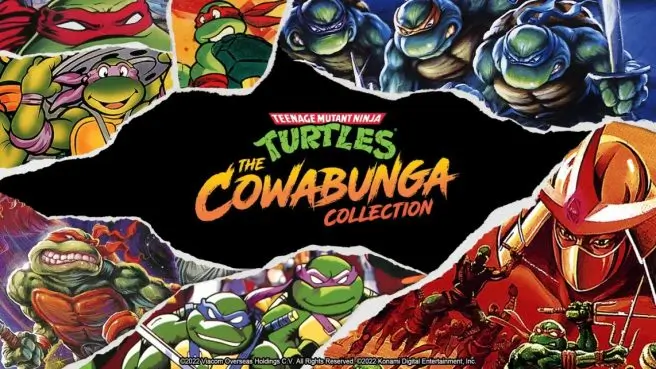
Introduction
After releasing multiple collections of Castlevania games, Contra games, Arcade games and so on, Konami has now turned its attention to some of its most cherished licensed games. Back in the 1980s and early 90s, the Teenage Mutant Ninja Turtles were the biggest thing around and appeared in cartoons, comic books and more. Video games were the next step and Konami answered the call by producing some truly memorable games.
What is included?
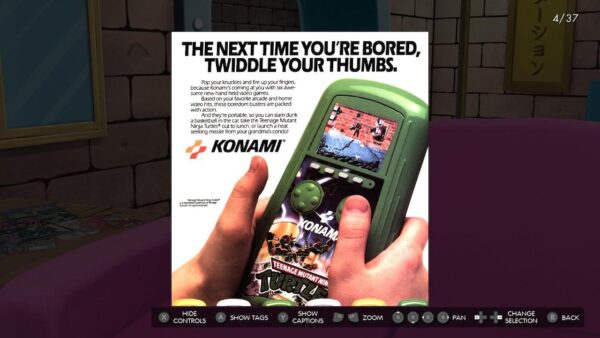
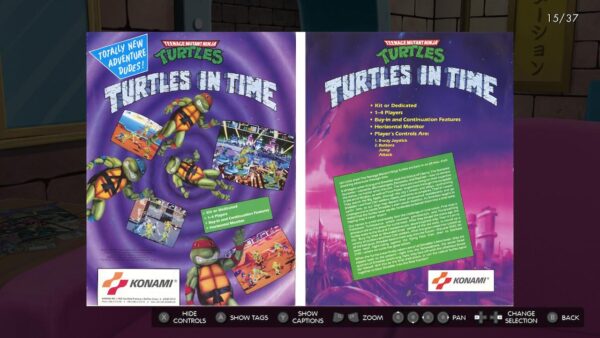
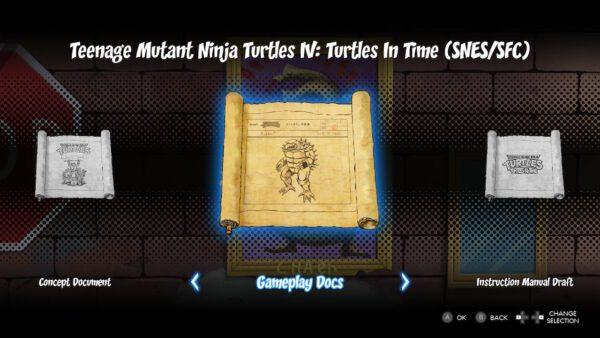
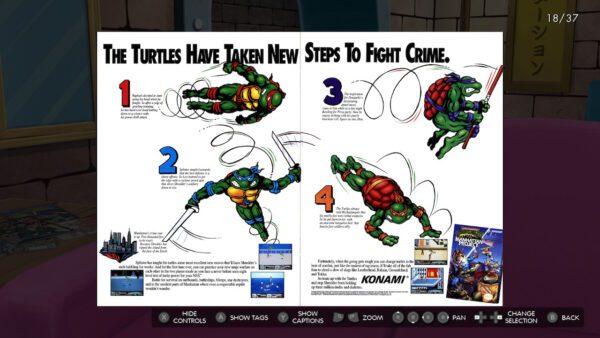
While we have a new TMNT game that is truly awesome, Teenage Mutant Ninja Turtles the Cowabunga Collection is a treasure trove as it contains most of Konami’s TMNT games based on the 1987 cartoon series, from TMNT on the NES to Radical Rescue on the Game Boy and there is quite a lot more as well. In addition to each of the games, there is a wide variety of bonus material including ads for the games, box arts for both the western and Japanese versions, images from the various cartoon incarnations, a look at the various comic books and so on. There is also a music player, and a lot of concept art and design documents for the games that will excite anyone interested in gaming history.
Enhancements and Improvements
Before going into detail on the individual games, it is important to note what Digital Eclipse did to improve the experience, as Teenage Mutant Ninja Turtles the Cowabunga Collection takes the best of multiple collections enhancements and places them in one. Like the SNK 40th Anniversary Collection, there are rewind features and save states and an option to let the game play itself until you want to jump in, which is a great touch for those stuck in an area. And like the Double Dragon & Kunio-Kun: Retro Brawler Brawler Bundle, there are optional enhancements that can fix up a game, such as removing slowdown and sprite flicker, which completely changes how a game like TMNT on NES plays.
The latter of these enhancements need to be turned on manually, but there is a lot more to them. They also contain many optional cheats, such as God Mode or infinite lives for some games, new moves, or unlocking multiple secret characters in the fighting games. While many games still have cheats that can be entered manually, these enhancements really make the experience more convenient.
And now onto the games.
The Games
TMNT (NES)
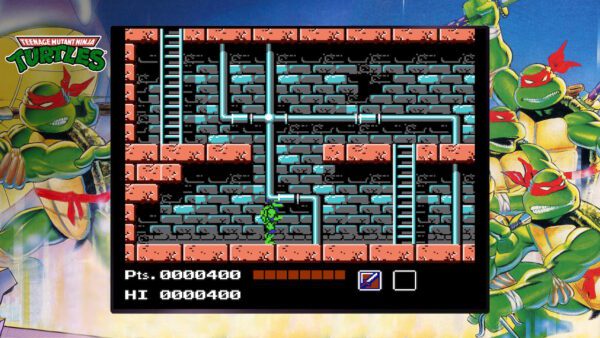
This game is infamous as a frustrating experience full of awkward game design, but a lot of that is overblown. Much of the hate seems to come from the review by the Angry Video game Nerd, but people forget that was a satirical review and Cinemassacre later did a video pointing out how many of the complaints were not accurate and that the game is actually good.
The game is designed to teach you how to play without the need for a tutorial, but placing objects and enemies in locations that encouraged you to figure things out on your own. If a turtle gets captured you can rescue them later, and you are encouraged to switch characters regularly to use each to their advantage. Far from a bad game, this is a well-designed experience that admittedly took some liberties when coming up with ideas used in the game.
Still, the music is great and thanks to enhancements, plays like a brand new experience here. Even the Dam section is not as bad thanks to save-states and rewind features, and the in-game strategy guide that is part of each game in the collection has a lot of great tips on figuring things out. This is where the Turtles video game adventure began and it is not a bad one at all.
TMNT Arcade

One of the more well-known games, this was a staple in every arcade back in the day. Bright visuals and simple yet effective gameplay made this a must play with friends, in a game that was based on the early seasons of the show and gave gamers a chance to go all out as the Heroes In A Half Shell. If you are more into recent beat ‘em ups and feel older games in the genre are hard to go back to, you may be surprised at how well this still holds up in terms of gameplay and audio/visual presentation.
There is a basic plot here, but Konami games were very much like that in the arcades (The Simpsons comes to mind here), using basic excuse plots to get to the action. But really, all that matters is that the game was a well-designed and fun brawler that, while simplified when compared to a game like Double Dragon, has aged far better and is a treat for old school fans. The voice lines may get a bit repetitive at times, but the game overall is an experience that just does not get old.
TMNT II The Arcade Game (NES)
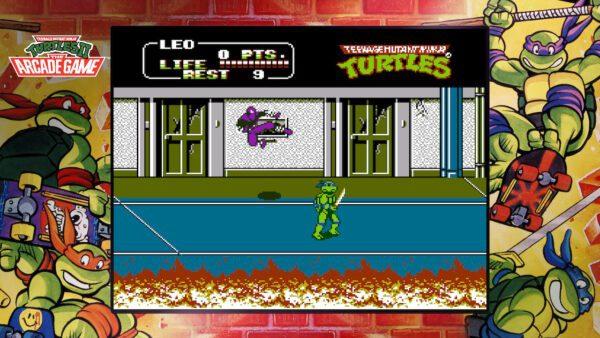
There were many different conversions of the arcade game for home systems, such as microcomputers in Europe, but the best conversion was to the NES. This version scaled back the graphics and reduced 4-player action to 2-player, but the overall experience was there. The game controls extremely well on the NES and with enhancement options in the collection, this is one of the best arcade conversions to NES.
Before going any further, no the Pizza Hut product placement is not here in this version, but the game is otherwise the same. This version has two extra levels not present in the arcade game, and a slight rebalancing of how the moves worked. It overall feels fine and while the arcade game was obviously better, this is a fine game in its own right.
Teenage Mutant Ninja Turtles: Turtles in Time (Arcade)
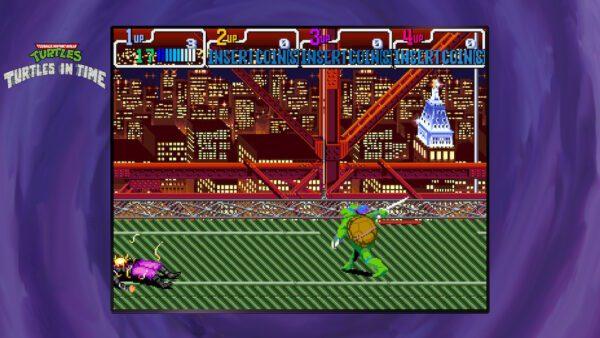
The follow-up to the arcade hit, Turtles in Time was bigger and better in every way. The game stood out more visually, there were new moves to use, and an interesting hook to the game allowed for a wide variety of level design. This time, Shredder sends the turtles across different time periods and our heroes must fight their way back to save the day.
Turtles in Time is a very well-regarded beat ‘em up, though the story does make very little sense at least in the arcade version. What works though is the amazing stages you fight in, new concepts such as flinging enemies into the screen, and some of the best music the turtles have ever had. There are enhancements available for the arcade release that includes a turbo mode where the game’s speed is increased drastically, creating a very different experience than you may be used to. This is a good game, but it was made better, and we will get to that.
Teenage Mutant Ninja Turtles III The Manhattan Project (NES)
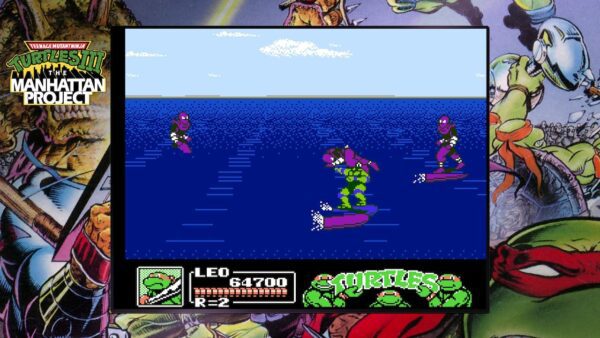
This NES follow-up to the NES conversion of the arcade game expanded on what came before. With a plot of Shredder raising Manhattan Island into the sky and capturing April, the turtles must get from Key West Florida where they were vacationing, and head back to New York. This game builds on the previous NES game by adding new techniques, new stage concepts, new abilities and so on.
New stages such as surfing stages were added, and while some music was reused from Turtles in Time from the arcade, the original music present is also amazing. This is an underrated gem that sadly gets overlooked a bit too much, and the enhancements available make this an awesome experience. Infinite lives, no slowdown and flicker and so on create an experience that anyone can get into and enjoy. This is the best of the NES turtles games by far and one that accomplished its task of building on what came before.
Teenage Mutant Ninja Turtles IV Turtles In Time (SNES)
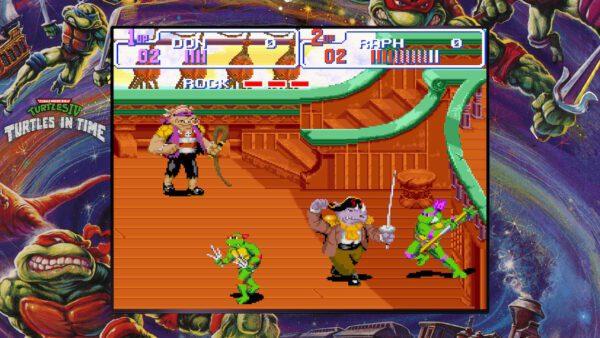
The SNES port of Turtles in Time is widely considered to be one of the best beat ‘em ups of all time and for good reason. The controls are slightly tweaked, and while the four-player option is reduced to two-player, the game is still amazing. The visuals are slightly scaled back, but the music is somehow even better in this version, but what makes the game so amazing is the gameplay itself.
Turtles in Time on SNES changes up some of the stages, adds new levels and fixes the plot issue in terms of how the Turtles are sent through time. Existing stages like Neon Night Riders were changed completely, this time to make use of Mode 7 effects, while a technodrome stage was added that featured a boss fight that involved hurling enemies into the screen. In other stages, bosses have been changed up, such as by bringing back Bebop and Rocksteady, and yet the changes never hurt the game but just made it better.
This was the game to beat for a long time and while Shredder’s Revenge has surpassed it now, Turtles in Time on the SNES is still a must-play experience.
Teenage Mutant Ninja Turtles The Hyperstone Heist (Genesis/Mega Drive)
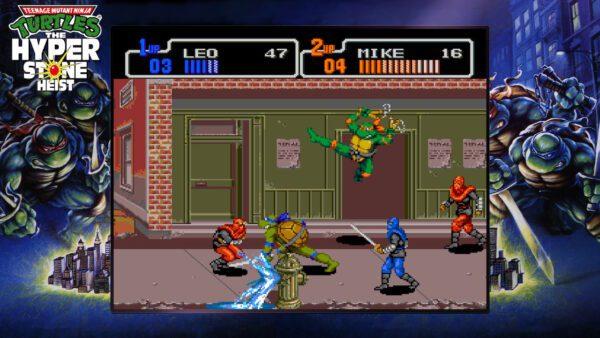
Often considered a reworked version of Turtles in Time, The Hyperstone Heist is actually a best-of experience as it combines multiple elements from previous games. The plot takes cues from the Manhattan Projects, and stages from that game as well as the original arcade game and Turtles in Time are present in some form. There are original stages of course, and changes to what was used as well, for instance, you cannot throw enemies into the screen, but the combat feels slightly different here.
This game has a second ending if beaten on the hardest difficulty setting, but for those who cannot complete it, the strategy guide included will let you watch it anytime you want. Overall, this is a game that is sadly in the shadow of Turtles in Time, and while it is definitely not better than the SNES game, it is a very solid experience in its own right and offers a lot of satisfaction for TMNT fans. The music is a bit hit or miss depending on if you like Mega Drive/Genesis music or not, but The Hyperstone Heist remains one of the best Konami experiences on that system period.
Teenage Mutant Ninja Turtles Tournament Fighters (NES, SNES, Genesis/Mega Drive)
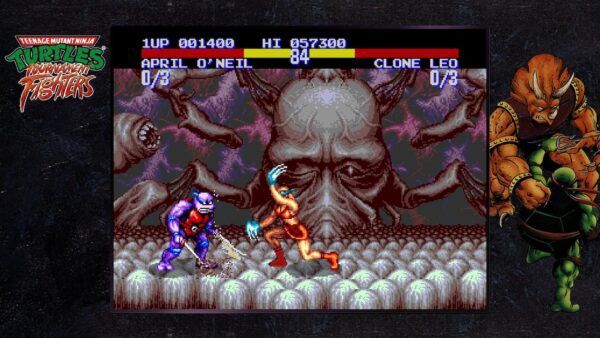
Each version of Tournament Fighters was different and had different rosters and concepts. The NES game had a very limited roster and for the last Konami release on the NES, really tried to be something special. Sadly, it is lacking and while an okay game, it just cannot match up to the 16-bit experiences. That said though, it is a nice curiosity in the collection and worth checking out at least once.
The SNES version is widely considered to be the best version and is the only one included here with online play. The combat is fast and fluid and while some character choices are odd ( who is Aska exactly?), the gameplay holds up well. This is a decent if somewhat derivative fighting game and you can easily lose several hours just playing against others while learning all the moves and enjoying the story.
The Mega Drive/Genesis version is the 2nd best game version, with a different roster and story. April is a playable character here and there is a style that feels less overly polished and more intentionally rough in terms of presentation. This is also a very good fighting game, but the game does feel a bit unbalanced compared to the SNES title.
All versions have enhancements available, most notably unlocking multiple extra characters. These are all worth checking out to some extent, but the SNES title just stands above all others.
Teenage Mutant Ninja Turtles: Fall of the Foot Clan (Game Boy)
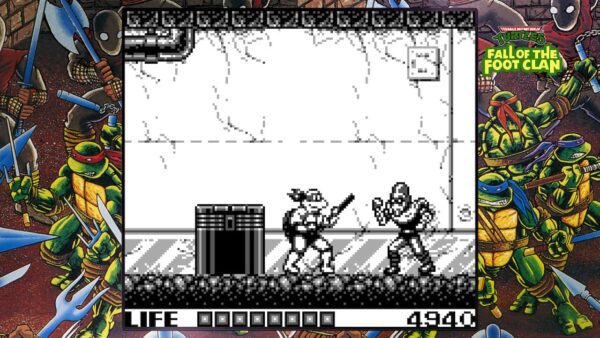
The first Game Boy game, Fall of the Foot Clan is a bit basic as a side scroller but is still fun to play. There are a number of secrets to find, and the music is actually very good for Game Boy. The strategy guide has a good listing of where the secrets are, and there is a cheat that can also be turned on via an enhancement, that allows you to play the bonus stages.
A decent game, if a simple one, Fall of the Foot Clan was a good start for the Game Boy games but better entries arrived.
Teenage Mutant Ninja Turtles: Back from the Sewers (Game Boy)
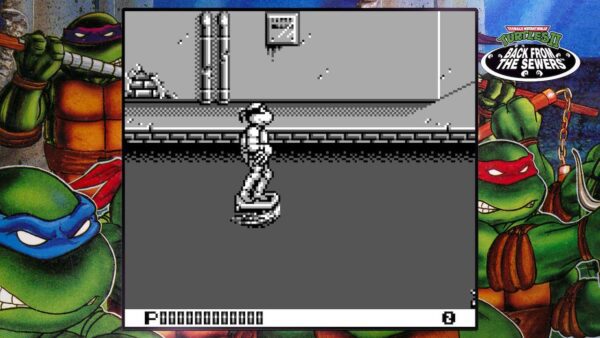
The sequel to Fall of The Foot Clan Back from the Sewers plays much the same as its predecessor but does have some changes as well. You can now use new moves like slide attacks and can rescue a captured turtle after a stage is complete. The art style is much improved as everything feels like a step up.
Back from the Sewers features several difficulty settings that change up the gameplay. Some settings will make more powerful enemies appear and others will give the bosses extra attacks. This was a great touch and managed to give some great replay to the game.
Teenage Mutant Ninja Turtles: Radical Rescue (Game Boy)

The most inventive game in the collection, Radical Rescue is not a typical side scroller or beat ‘em up. This is a Metroidvania that sees you start out as Michelangelo and setting out to rescue the other turtles as well as April and Splinter. Each turtle has its own ability to help them get around areas better and using each one correctly is the key to success.
This is a concept that was done well here, and while there were other Metroidvania based on the TMNT, this remains the best one. Excellent music, excellent gameplay and actual innovation made this a standout. It would have been great if Konami had done more with this idea in other games, but as it stands, Radical Rescue is one of the best games in the series.
Online
Four games have online play here, the first Arcade game, Turtles in Time Arcade, The Hyperstone Heist and Tournament Fighters SNES version. The online works very well here, with no real lag or hiccups and makes for a great experience. It would have been nice to play the SNES version of Turtles In Time online as well, but what we have is still great. Playing online matches in Tournament Fighters is a great experience and something you can just lose yourself in while trying to constantly get better.
What Is Missing?
Not every game from Konami is in this collection, as it only covers the games based on the 1987 series. The games based on the 2003 series may be saved for another collection one day. No microcomputer versions are included, but that may be due to rights issues, but the omission of the DOS game the Manhattan Missions, which was a unique game, is rather odd.
Conclusions
Overall, though, The Cowabunga Collection is a must-play treasure trove for any TMNT fan. With the amount of care put into this collection and the amount of extras and enhancements, this stands out far above other retro collections. It is not an exaggeration to say that it will be a long time before we get another retro collection like this.
Disclaimer: A review key was provided

